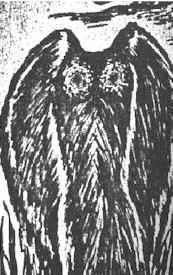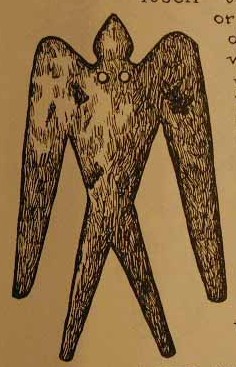

(A Striking Resemblance Between the "Mothman" and an Abenaki Thunderbird Artifact)
Report: August 2002 by Daniel V. Boudillion
The purpose of this report is to draw attention to similarities between a 1850's Abenaki Indian Thunderbird artifact, and the descriptions of an anomalous and frightening figure seen repeatedly in 1967, dubbed "The Mothman".
Mothman History:
The Mothman is one of the strangest and most terrifying of anomalous creatures ever to be recorded in America. Between November 12, 1966 and December 15, 1967, it terrorized citizens in the Point Pleasant area of West Virginia. It was said to have been encountered by at least 100 people over the course of that year.
According to author John A. Keel (The Mothman Prophecies, 1975) who was on hand investigating the reports during the time of the sightings, the creature was reported to be roughly man-shaped, either grey or brown, and between five and seven feet tall. Its body was wider than a man's. It did not appear to have a head, but rather its "eyes" were set on the upper chest. These "eyes" were very large, and alternately described as glowing red lights, or a reflected red like a bicycle reflector. When it walked it shuffled on what appeared to be human-like legs. Rather than arms it had bat-like wings which it did not flap. It was always seen to glide. The non-flapping of the wings, even in ascent, is particularly disturbing. Indeed, it was reported to regularly ascend straight up like a helicopter - and again be it noted, without any wing-action. In flight it emitted a humming sound. Occasionally it was heard to emit a screeching sound something like a woman screaming. (This "woman screaming" sound is common among anomalous creatures, particularly the Bigfoot creatures.)
Recently, interest in Mothman has been rekindled due to the release of the movie The Mothman Prophecies starring Richard Gere. Cryptozoologist Loren Colman has also contributed a new book on the subject: Mothman & Other Curious Encounters (2002).
For comprehensive accounts of the Point Pleasant/Mothman events, please refer to links such as: mothmanlives.com.
Thunderbird Artifact:
On June 15, 2002 I was visiting the Fruitlands Museum in Harvard Massachusetts. While in the Indian Museum, I noticed an artifact that bore a startling resemblance to Mothman descriptions. This artifact is ten inches tall, made of copper sheet, and is attributed to an Abenaki Indian in Maine, circa 1850. It is labeled: Thunderbird.
The main difference between the Mothman descriptions and the Thunderbird artifact is that the artifact is crafted with a head, while the Mothman is typically described as having no head. The general body shape - other then the head discrepancy - is identical. The most striking similarity is the "eye" placement. The Thunderbird artifact has two holes placed on the upper chest, same as Mothman descriptions. Presently, these "eyes" on the Thunderbird artifact are being used as string holes to lace the figure to a museum stand. I enquired of the Museum Staff if the holes were meant as "eyes", or were merely lacing holes. They did not know, but gave their opinion that as "eyes", they were very compelling. I also asked if the holes were part of the original creation or were added later as lacing holes, but the staff was unable to provide information on this. Currently, the Thunderbird artifact is on loan to Fruitlands from a museum in New Hampshire.
Comparison:
Loren Coleman, in his recent book Mothman & Other Curious Encounters, created a composite sketch of the Mothman based on the various reports and eyewitness testimony. Please see Loren's composite sketch, below left. To the right is a scan of the Thunderbird artifact from the book The New England Indians by C. Keith Wilbur.


Mothman Thunderbird
Thunderbird Lore:
Although primarily associated with the Plains Indians, the Thunderbird was known to the Algonquin speaking peoples of New England. However, like most Native American culture in New England, little is now known of their beliefs. In regards to the Thunderbird, this much is known: it was a fearsome being and resembled a winged man, it caused fear and dread, and was said to actually kill humans from time to time. (Jim Brandon - The Rebirth Of Pan)
Assessment:
There is a startling visual resemblance between the Mothman descriptions and the Thunderbird artifact. The single difference is the head - Thunderbird has one, Mothman doesn't. If the holes in the Thunderbird figure were intended as eyes, the identical placement of the eyes is a significant feature. With the exception of the head, the Thunderbird is a figure that exactly reproduces the Mothman descriptions.
A second resemblance is its perceived disposition: the citizens of Point Pleasant felt terrorized by the Mothman - the Thunderbird was a figure of dread and fear in the culture of the Abenaki craftsman who created the copper figure.
Conclusions:
The question is not whether there is or is not a strange "Mothman" creature that troubled folks in West Virginia, or whether there really is a Thunderbird being that the Abenaki of Maine fear - the point is that both cultures have legend of it, and the images of this creature - with the exception of the head motif in this instance - are identical.
If there are strange anomalous beings, perhaps they are definable by type - much in the way the reports of lake monsters and Bigfoot are recognizable "types". If so, whatever produces these phenomena appears to be consistent in its types. I find it curious that two cultures separated by 100 years, 750 miles, and dissimilar cultures have recorded a particular "type" in almost exact detail.
I would say that there are grounds for suggesting that the good folks at Point Pleasant and the fine Abenakis of Maine were reporting images of the same being - whatever that being may really be.